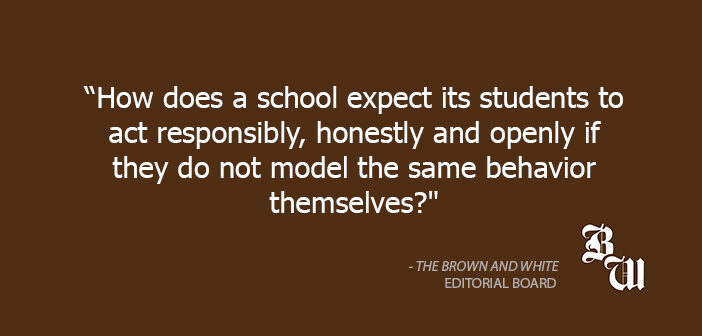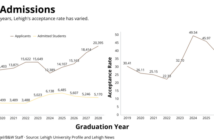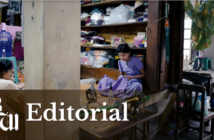 When it comes to testing, Lehigh’s administration has been taking a page out of the playbook of the White House.
When it comes to testing, Lehigh’s administration has been taking a page out of the playbook of the White House.
During the first two weeks of the fall semester, Lehigh University administered thousands of COVID-19 tests to gauge the health of the campus community. Within those first two weeks, there were fewer than 15 positive cases, as indicated by the Lehigh COVID-19 dashboard.
After the first two weeks of surveillance testing, no more tests were administered on a routine basis. Students who felt sick were administered a test from the Health and Wellness Center, and were sent on their way.
Six weeks later, throughout the last week of September and first of October, case numbers rose exponentially to 100, as of Oct. 7. The number of students in quarantine between on and off-campus is at 269.
On Oct. 2, the university implemented a two week “scale back” of campus activities, which involved a number of campus facilities and academic buildings closing as well as a halt to in-person instruction.
The scale-back also involved a serious order for 2,000 COVID-19 tests to be conducted on Oct. 6 in order to assess the positivity rate among students.
During the week of the initial spike in cases, more students learned of possible exposure to positive cases and attempted to receive testing from the Health and Wellness Center, further spotlighting the struggle for students to gain access to a test. This forced students to find off-campus facilities to administer tests, some of which have turnaround times as long as seven days.
Indeed, the numbers don’t lie: 40 of the 100 positive cases were reported to the university after having been identified through tests administered by locations unaffiliated with Lehigh.
While it is on both the student’s and the administration’s hands to emphasize the importance and practice of COVID-19 safe behaviors, it is a team effort that stems from the top. When the school no longer preaches the importance of testing and staying on case numbers, the apathetic mentality trickles down throughout the student body.
It feels as though after having relatively low numbers during the initial testing phase, Lehigh administrators wiped their hands, said “that’s good enough,” and left the student body to handle the risks of the pandemic on their own.
But that isn’t what played out throughout September.
First of all, any plan to include further surveillance testing after the first two weeks of the semester was never communicated to students. So the argument of “we were always going to do more” is made in bad faith.
The COVID-19 dashboard is not entirely accurate. It does not include the number of “recovered” cases. And until recently, it was not updated in a timely manner.
This increasing spike could’ve been mitigated by transparent and consistent communication. We have said this time and time again when it came to discussing reopening plans, which while frustrating, did not cause any imminent threat.
But this time, it does.
COVID-19 is believed to have less severe impacts on people in their late-teens and early 20s but still has the potential to get this demographic and others sick. These students are interacting with not only professors and university staff, but also members of the greater Bethlehem community. It is quite literally to no one’s advantage to leave the campus community in the dark.
There are a plethora of rumors flying around the campus as to what changes may take place in the coming weeks, and we hope the administration addresses its thinking and shares it in a responsible manner.
How does a school expect its students to act responsibly, honestly and openly if they do not model that same behavior themselves?
While we are frustrated with how the administration has handled the pandemic since our return to campus — and before — we understand that the responsibility also lies on us. There is a social contract that all students returning to Bethlehem signed, agreeing to take part in socially responsible behaviors amidst a very difficult time.
But at the end of the day, it shouldn’t be the university’s newspaper to serve as the only bridge between the administration and the student body.
The inability for the administration to hold themselves accountable during a time when its community is the most reliant on them it has ever been is disheartening to say the least.
Be open with us. Keep us informed. Let us know where the administration’s head is at. It can only go to assist student and staff decision-making to make our campus healthier as a whole.






Comment policy
Comments posted to The Brown and White website are reviewed by a moderator before being approved. Incendiary speech or harassing language, including comments targeted at individuals, may be deemed unacceptable and not published. Spam and other soliciting will also be declined.
The Brown and White also reserves the right to not publish entirely anonymous comments.
2 Comments
Welcome to Venezuela
Editorial takes its time finding its point. Are you calling for routine mandatory UIUC-style testing throughout the semester? If not, what sort of info do you think ought to be communicated, and given that a lot of it’s likely to be “we don’t know” and “we are trying” and “that thing we decided on yesterday turns out not to be possible today,” what do you want to do with it? Also, is this about testing specifically, or covid-response generally? Do you want a student rep in admin decisions on these things, or what?
Regardless: 2000 tests strikes me as a small order if you’ve got an outbreak in a community of several thousands, including staff and faculty, particularly since you need more than one test to catch new infections. Why so small? Also, if getting tested at the Health Center is a problem, is there a visiting-nurse or other organization that will open a tent or van just off-campus, and at least make off-campus testing convenient?
As for impacts on young people: 1 in 5 people under 25 is expected to have difficulty recovering, with debilitating symptoms lasting for weeks. Smoking, diabetes, and obesity are significant risk factors. Myocardial inflammation persists in most people for weeks, even months after diagnosis, again even in young people. While the illness won’t likely kill you, we know that in the near term, for young people, it has real and palpable long-lasting effects for weeks to months, and we don’t know anything about longer-term effects.
Incidentally, what you’re getting is a little taste of life pre-ACA. You knew that healthcare existed somewhere, but the odds of your being able to get it when you needed it weren’t great, you might not have been able to get to wherever it was, and you had no idea what you might have to pay for it. (Literally no idea in those days. You’d call a hospital, trying to be a responsible consumer, and get told that the information about what procedures cost was proprietary, between the hospital and insurance co. Would it cost hundreds? Thousands? Tens of thousands? No info.)